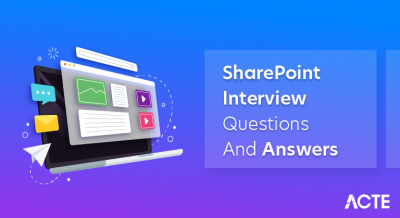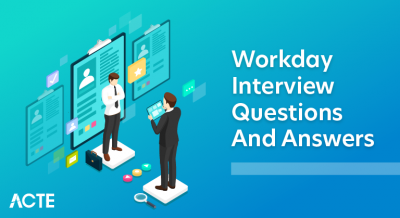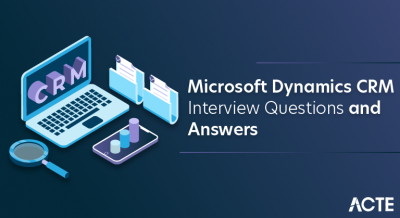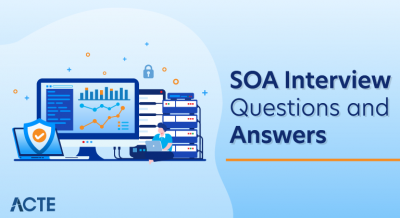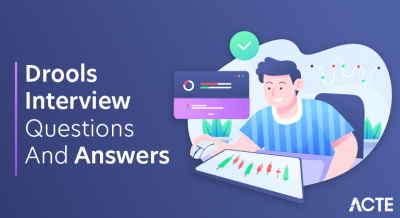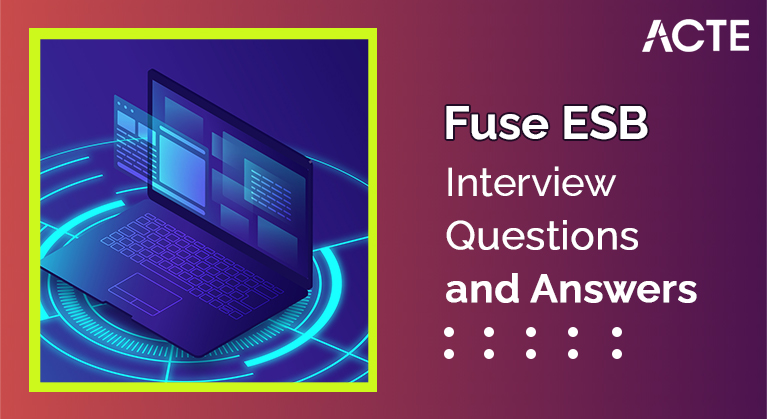
Fuse ESB (Enterprise Service Bus) is a comprehensive integration platform designed to facilitate seamless communication and data exchange between disparate applications and systems within an enterprise. As a critical component of integration architecture, Fuse ESB empowers organizations to create flexible, scalable, and efficient solutions for managing diverse data and services. Given its significance in modern enterprise IT ecosystems, professionals seeking roles in integration, middleware development, or system architecture may encounter specific interview questions related to Fuse ESB.
1. What does OSGi stand for in full?
Ans:
The Open Source Gateway program. The Java framework known as OSGi, or Open Service Gateway Initiative, is used to create and implement modular software applications and libraries. Essentially, OSGi serves as the Java application’s “modularity layer.”
2. What is an ESB?
Ans:
To link and manage the interaction of a large number of different applications across extended businesses with transactional integrity, an ESB is a standards-based integration platform that integrates messaging, web services, data transformation, and intelligent routing.
3. What does JBoss Fuse support the various containers?
Ans:
- Apache Karaf
- Enterprise Application Platform for JBoss
Three distinct deployment modes are supported by the Red Hat JBoss Fuse container: FAB, WAR, and OSGi bundle deployment. It is a versatile container. Additionally, the container integrates with Apache Maven, enabling dynamic download and installation of necessary artifacts during deployment.
4. Describe the Apache Camel.
Ans:
JBoss Fuse uses hats in Red Enterprise Integration Patterns (EIPs) to construct integration and routing solutions using Apache Camel. Every route delineates an integration pathway connecting endpoints, enabling a system to transmit or receive messages. Within these pathways, data undergo transformation, validation, interception, and other processes. Routes provide the ability to alter endpoints in response to the content of messages dynamically, the activation of new bundles, or other factors.
5. What are the various parts of the JBoss Fuse?
Ans:
- Fabric8;
- Switchyard;
- Apache Camel;
- Apache CXF; and
- Apache ActiveMQ
6. What characteristics ought an integration application have?
Ans:
Every integration program includes capabilities that enable it to carry out its function, depending on the situation and other comparable elements. Some are mentioned in the list below.
- It must function regardless of the technology that the other apps depend on for integration.
- It must make it possible for businesses to monitor and manage every app centrally.
- The required bandwidth needs to be in line with the organization’s requirements.
- It needs to be bug-free in every way.
- The integration application needs to be accurate, precise, and dependable.
7. What are the top three reasons a firm should integrate applications?
Ans:
- A significant amount of time and money saved.
- Users may make sure that all the information they need is available while working on a particular task, and in fact, technology guarantees greater results.
- It is possible to guarantee efficiency, dependability, and increased output all at once.
8. Describe Apache CXF and it’s architecture.
Ans:
As part of an integration solution, Red Hat JBoss Fuse’s embedded Web and RESTful services framework, which is based on Apache CXF, offers a tiny footprint engine for building reusable web services and service-enabling both new and existing applications. Red Hat JBoss Fuse is compatible with many web service creation standards and protocols, including WSDL and SOAP. The core of CXF lies in its Frontend API, offering a range of abstractions and annotations for the definition of web services. Developers utilize this API to establish service endpoints, articulate data types, and configure diverse aspects of web service behavior.
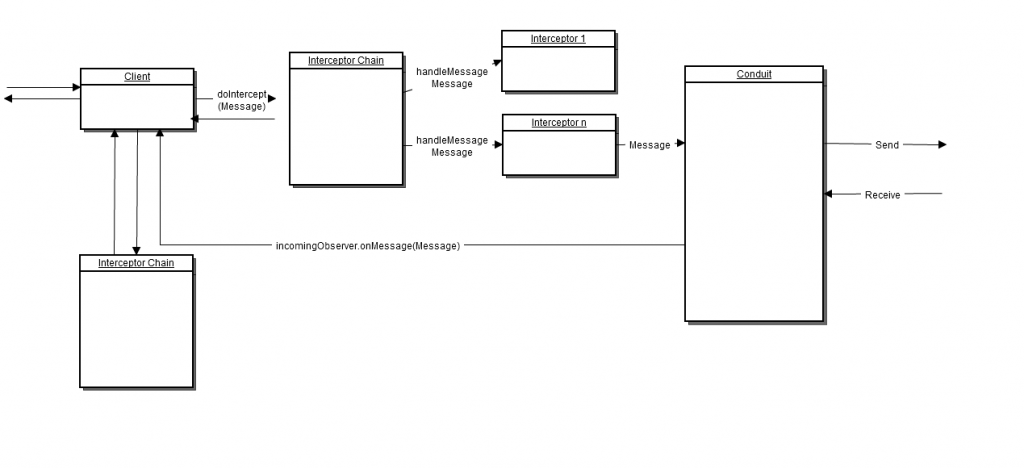
9. Describe Apache ActiveMQ.
Ans:
Apache ActiveMQ is the foundation for the embedded messaging service in Red Hat JBoss Fuse. In addition to offering a large range of additional JMS functionality for creating dependable and durable messaging systems, it supports the standard JMS 1.1 functionalities. Red Hat JBoss Fuse is a set of client-side libraries and a messaging broker that allows distributed client applications to communicate with each other remotely.
10. Explain the Fabric8 .
Ans:
Fuse Fabric is a technology layer that enables a collection of containers to create a cluster that shares a common set of repositories for runtime artifacts and a shared set of configuration data. Among other advantages, this enables the running of several containers on your hardware or in an open hybrid cloud. Configuration management, load balancing, failover for service discovery, and centralized monitoring are also possible.
11. Mention two typical application integration patterns.
Ans:
- Meditation, sometimes referred to as intra communication
- Federalism, sometimes referred to as inter-communication
12. How can session logs be removed from the IS?
Ans:
By accessing the installation folder, selecting the integration server file, and then selecting logs, you can remove these. They still contain every file in the.log format. Any file can be directly erased from that point on.
13. What is the Switchyard?
Ans:
Switchyard is a lightweight framework for service delivery that offers complete lifecycle assistance for creating, implementing, and overseeing applications that are service-oriented. It is made up of parts like composite services and composite references and enables you to operate and deploy services with few dependencies.
14. Distinguish JBoss Fuse’s blueprint and spring dependency injection frameworks from one another.
Ans:
| Feature | JBoss Fuse Blueprint | Spring Dependency Injection | |
| Framework | Type OSGi Blueprint Container | General-Purpose Dependency Injection Framework | |
| Use in JBoss Fuse | Native support within JBoss Fuse for OSGi components | Widely used in various Java applications and frameworks | |
| XML Configuration | Uses XML-based configuration (Blueprint XML) | Uses XML-based configuration (Spring XML) | |
| Annotation Support | Limited support for annotations | Extensive support for annotations | |
| Programmatic Configuration | Limited programmatic configuration capabilities | Extensive programmatic configuration capabilities | |
| Component Scanning | Limited support for component scanning | Extensive support for component scanning |
15. Explain the Apache Karaf.
Ans:
The foundation of Red Hat JBoss Fuse is Apache Karaf. This OSGi-based runtime container is strong, lightweight, and designed to manage bundles in order to make it easier for Red Hat JBoss Fuse applications to be componentized. To further bind the lifecycle to the operating system, Red Hat JBoss Fuse offers native OS integration and may be integrated as a service, the ability to deploy OSGi bundles both hot and manually, and a variety of installation methods for libraries and applications.
16. Describe JBOSS EAP responses.
Ans:
Flexible, modular architecture, JBoss EAP 6 is a JEE-certified container that combines web services, security, clustering, and EJB components. You can access all JEE components, including the injection framework and persistence, by using a JEE container.
17. What do you mean by the phrase integration? How might it be applied in a corporate setting?
Ans:
Integration is simply drawing two distinct machines, tools, apps, devices, or anything else together in order to complete a task or achieve a particular outcome. Businesses now depend on it to complete their jobs efficiently and effectively—and, most of all, without having to spend a lot of money. a substantial amount of commerce in order to stay up with the times, this technology is being adopted.
18. Is it possible to properly link the apps with one another when they are hosted on the cloud?
Ans:
It is really easy to accomplish this. It is well recognized that FuseESB provides positive outcomes in this regard. This method is widely accepted; therefore, there is no need to worry about anything.
19. List three benefits of applications for data or information integration.
Ans:
The use of such an application has several benefits. The top ones are:
- The apps or data can be integrated regardless of where they are located. Within a network.
- It constantly ensures that there are multiple functionalities and solutions available to carry out a particular task.
- Apps are able to be managed and observed centrally.
20. What does the term “ESB” represent to you? What role does it play in the integration of data or information?
Ans:
- The acronym ESB denotes Enterprise Service Bus. When it comes to creating an easily navigable conduit between software programs.
- This method works well. It might take on any shape. To put this strategy into practice, further tools and apps are occasionally required.
- Simple channels can be used to connect apps if they are simple. There is a limit to this strategy, though alternative strategies like FuseESB are taken into consideration.
21. What does application integration compare to automation?
Ans:
- Despite their apparent similarities, automation and application integration are two distinct methodologies.
- Unlike application integration, automation allows operations to be managed and controlled without human interaction.
- In application integration, users oversee and manage every subprocess.
- Although these two approaches are quite different, they have one thing in common: they facilitate communication between various applications.
22. Can an organization rely on just one app to complete its tasks? What happens if they rely on one?
Ans:
Nowadays, businesses are getting harder and harder to understand and run. Every organization can only do some of its maintenance with one application. Naturally, a lot is always required. Frequently, their applications are still available in another branch office even though they are different from where they want them to be. The FuseESB technique can be taken into consideration in this kind of circumstance since it provides incredibly dependable outcomes to achieve the most desired outcomes.
23. What is an integration of applications? What does it mean?
Ans:
When an application is only available at a certain place, application integration refers to the process of accessing it from several locations. Put differently, application integration refers to the process of connecting or repairing several business applications so that authorized users can access them from any location at any time. It guarantees quicker operations while saving money. Because of the wide range of advantages that this strategy can offer, many organizations have begun to consider it.
24. Define digital transformation.
Ans:
The technique of transferring information digitally is called digital transmission. Any given piece of data or information is typically only available in its original format, which makes it impossible to exchange or integrate. It must be digitized in order for the application and It is possible to integrate software. A common method for doing this is through digital transformation. Expertise and abilities are both necessary for a successful digital transition.
25. Explain knowledge of an integration module.
Ans:
An EAI system can be involved in many integration activities concurrently. An integration module manages each integration procedure.
26. How many connectors does the FuseESB have?
Ans:
- One hundred fifty connectors are provided with the FuseESB kit.
- Various Fuse Types Based on the kind of input supply voltage, fuses fall into two primary kinds.
- Fuse AC DC fuses DC and AC Fuses The AC and DC Fuses utilized in the AC and DC Systems differ slightly from one another.
27. Why, in the current situation, are businesses required to link all of the information sources?
Ans:
- These days, every team needs to complete certain responsibilities in order for the firm to function properly.
- It is accurate to state that there is a great deal of interdependence between these jobs and processes.
- To accomplish a certain goal, a user needs to have access to all available information. Thus, in any form, connecting the complete information source is essential.
28. What kind of company should think about integrating applications?
Ans:
Businesses of almost all stripes are implementing it; however, among the highest ranking are:
- ERP systems developers
- Applications for business intelligence
- Management of the supply chain
- Developers of CRM applications
- Systems for human resources
29. Define awareness of the FuseESB approach. What makes it unique?
Ans:
Owned by Red Hat Companies, it is a lightweight and adaptable integration platform that companies may use for rapid integration. It is the best because of its modular integration capabilities. When it comes to integration, any data from several apps can be readily unveiled.
30. What is the technique known as Software-as-a-Service?
Ans:
It is essentially the online software distribution and licensing paradigm that consumers can access through subscription. These programs are hosted centrally, and a web browser is required in order to use them to access the same.
31. What happens if the data being merged have different formats that the other programs?
Ans:
This issue is widespread, but it can be resolved. The first thing that should be done is to transform all of the data into a common or standard format. It takes a lot of time and effort to do manually. This capability is typically included with the integration application that is taken into consideration. It transforms all of the information or data into digital formats, which are often represented by 0s and 1s.
32. What aspects need to be taken into consideration when thinking about integrating?
Ans:
The data needs to be flawless and devoid of any errors. This is required since, in the future, it may prevent apps from functioning properly or even result in the provision of inaccurate information, which could result in losses. To achieve the desired results, it is also essential to test the integration apps.
33. What’s an application programming interface?
Ans:
- Application Programming Interface is a collection of definitions and protocols used in the development of certain applications.
- It is crucial to the advancement of other applications and integration. It may also be comprehensive data that outlines the strategies and tactics used by various software components to communicate with one another.
- Typically, it contains requirements for object classes, templates, data structures, remote calls, variables, procedures, and so on.
34. Give an acronym for UDAI.
Ans:
The acronym represents Uniform Data Access Int 30. Which factors must be taken care of before integrating application data?
- Data spectral resolution
- Formats
- Retrieval methods
- Methods of storage
35. What does enterprise application integration mean?
Ans:
It is a structure that often consists of a variety of technologies and services that are designed to make it easier for an organization to integrate its systems and applications. The objective is to load an application’s data into another.
36. Define automation results from application integration.
Ans:
It can help with this issue. Application integration by itself, however, can only encourage automation but might result in something different. If automation is all that the company wants, then they need to spend extra attention to stay on top of things.
37. Are there any negative aspects of application integrations, and is it possible to get rid of them?
Ans:
The process of application integration is extensive. Improving corporate productivity is the primary goal of this initiative, which goes beyond simply linking disparate apps. A significant disadvantage is a data leak. But this could be prevented. All other apps must wait to obtain direct access until they submit a request for it. It can, of course, prevent many problems associated with the same issue.
38. What might happen if communication breaks down between the systems or apps?
Ans:
- It can have a significant impact on collaboration, output, efficiency, and quality.
- A lot of simple processes can seem very intimidating. Furthermore, it can have a significant impact on an organization’s capacity to allocate resources and absorb losses.
- Large-scale losses are the result of any process that operates slowly.
39. What kind of integration takes into account their apps? Is it long-term or short-term?
Ans:
- It depends on what is needed. It is only sometimes required for all of the apps to always be integrated.
- Certain programs require special handling because of things like information security and confidentiality.
- On the other hand, apps in related categories and even those performing related tasks can be permanently merged.
40. Describe application integration; what are the typical issues that users run into?
Ans:
This method is generally error-free. However, when users make broad modifications to the application data, alter the data structure, or take other comparable actions, the issues may become apparent. Applications need to be connected according to their similarities and standards.
41. Describe Apache CXF.
Ans:
As part of an integration solution, Red Hat JBoss Fuse’s embedded Web and RESTful services framework, which is based on Apache CXF, offers a tiny footprint engine for building reusable web services and service-enabling both new and existing applications. Red Hat JBoss Fuse enables Contract-first or Code-first development with JAX-WS and supports a number of standards and protocols for building web services, including SOAP and WSDL.
42. What does Apache ActiveMQ mean?
Ans:
Apache ActiveMQ is the foundation for the embedded messaging service in Red Hat JBoss Fuse. Along with offering a plethora of additional JMS functionality, it supports the conventional JMS 1.1 functionalities, developing dependable and sturdy messaging apps. Red Hat JBoss Fuse is a set of client-side libraries and a messaging broker that allows distributed client applications to communicate with each other remotely. In addition to supporting both persistent and nonpersistent messages, Red Hat JBoss Fuse also supports Point-to-Point and Publish/Subscribe messaging.
43. What parts make up JBoss Fuse?
Ans:
The parts of the JBoss Fuse are as follows.
- Array Camel
- Array CXF
- Array ActiveMQ
- Array Fabric
- SwitchYard
44. What are the JBoss Fuse deployment models?
Ans:
JBoss Fuse offers three different deployment model options:
- OSGi bundle deployment model: By sharing all necessary dependencies, a bundle reduces resource usage.
- FAB deployment model: The FAB will incorporate the metadata. After examining the information, the JBoss Fuse container instils the necessary dependencies from Apache Maven on its own.
- WAR deployment model: All of a WAR’s dependencies are packaged with it. The container does not need to resolve the dependencies of the WAR because the libraries are present in the WAR.
45. Why is it that, in the current scenario, businesses need to connect all of their information sources?
Ans:
In order to manage a business efficiently, each group has specific responsibilities that must be fulfilled. It is accurate to state that these responsibilities and methods rely heavily on individual differences. To achieve the desired outcome, the user needs to have access to all relevant information at their disposal. Consequently, linking the complete data source is required in any business venture.
46. What is OSGi all about?
Ans:
The Open Services Gateway initiative (OSGi) is used to address Java EE environments’ loading problems. Around the OSGi container implementation is wrapped the JBoss Fuse. It facilitates the use of OSGi containers as runtime servers.
47. What is the JBoss Fuse container for Red Hat?
Ans:
Several deployment formats, including FAB, WAR, and OSGi bundle deployment, are supported by the Red Hat JBoss Fuse container. When it comes time to deploy, it can be combined with Apache Maven to download and install the necessary artefacts dynamically.
48. What Is the Provider-Software Approach?
Ans:
It is essentially an online software program’s licensing and shipping model that users can access largely through subscription. Programs or software in this category are hosted centrally, and access to them requires a web browser.
49. What Is The Meaning Of The Term “Esb”? What Does It Mean For The Integration Of Data?
Ans:
- The acronym ESB denotes Enterprise Service Bus. This approach is helpful for forcing a channel through which the software packages can easily communicate with one another.
- It might take in any form. It’s sometimes desirable to have an additional tool and level of awareness when using this method.
- A straightforward channel could join simple packages. This strategy is constrained, though thus other methods that use FuseESB are taken into consideration.
50. What features should an integration application have?
Ans:
Every integration application can successfully do its task, depending on the situation and other relevant variables. Below is an index of a handful of them:
- It should make it possible for agencies to access and control every app in one place.
- The bandwidth needed should be in line with what the business needs.
- It needs to be freed from all insect forms.
- The integration tool should be accurate and precise at the same time.
- It must give users access to integrate a vast array of apps with one another.
51. Define the data integration format problem.
Ans:
This problem is frequent, but there is a fix for it. First, all the information must be translated into a common or general layout if one is to be considered. It is too time-consuming and labour-intensive to be completed by hand. This capability is typically included with the mixing application that is taken into account. It transforms all of the data into virtual formats, which are often represented by zeros and ones.
52. How many connectors does the Fuse ESB offer?
Ans:
More than 150 connectors are available from JBoss Fuse and are ready to use. It allows for the integration of services and apps on-site, in the cloud, and on mobile devices for the extended workplace.
53. What Are The Important Considerations Before Thinking About Data Or Application Integration?
Ans:
The information must be of the highest caliber and devoid of any bugs. This is significant because, in the future, it may interfere with an app’s functionality or even result in the provision of misleading information, which could result in losses. To obtain the desired results, it’s also crucial to test the mixing apps.
54. What Does Application Integration Mean? What Role Does It Play?
Ans:
Application integration refers to the ability to use a chosen utility while it’s closest to you in the most efficient way, from several locations. Put another way, software integration is the process of integrating or repairing a business’s unique program with each distinct in order to authorize authorized clients to access them at any time or any place.
55. What Are the Top Three Reasons for a Business to Integrate Applications?
Ans:
- Significant savings in terms of both time and money.
- Users may ensure the availability of all the records and, in actuality, technology that ensures superior outcomes.
- It is possible to ensure reliability, efficiency and increased output all at once.
56. What Exactly Is an API? Does the same apply to the integration of data and applications?
Ans:
- Application Programming Interface, or API, is essentially a set of defined protocols and terms needed to construct a certain type of software.
- It has a significant role in the advancement and integration of many projects.
- It can also be focused data that describes the methods and approaches via which unique software components communicate with one another.
- Typically, it contains specifications for item classes, templates, remote calls, workouts, variables, statistics, shapes, and more.
57. What Specific Knowledge Do You Possess?
Ans:
It is basically a flexible and lightweight integration platform that businesses should remember for speedy integration. Red Hat organizations own it. Its ability to integrate modules is precisely what makes it pleasant in every way. It is easy to uncover any data from outstanding apps with regard to integration.
58. What is The Software-as-a-provider Approach?
Ans:
It is essentially an online software program’s licensing and shipping model that users can access largely through subscription. This class’s software and applications are hosted centrally, and a web browser is required to get admission to the same.
59. What Are the Top Three Reasons for a Business to Integrate Applications?
Ans:
The significant time and cost savings. Users can ensure that all records are available while performing a specific task, and in fact, technology actually ensures better outcomes. It is possible to guarantee efficiency, dependability, and increased output all at once.
60. What Are The Things To Look Out For Before Thinking About Data Integration?
Ans:
The information must be of the highest calibre and devoid of any insects of any kind. This is significant because, in the future, it may interfere with an app’s functionality or even result in the provision of misleading information, which could result in losses. To obtain the desired results, it’s also crucial to test the mixing apps.
61. Which Business Types Can Take Into Account Application?
Ans:
The majority of groups are embracing it, yet the following are the ones that have the potential to succeed:
- ERP framework creators
- Utility for business intelligence
- Chain of supply management
- Creators of CRM applications
- Structures for human resources
62. Define Two Frequently Used Integration Patterns in Application Integration.
Ans:
- Sending a single message from the sender system to several recipient systems is known as the broadcast pattern, Correlation Data Integration Pattern.
- It ensures correctness and consistency across numerous systems by connecting individual signals from disparate interactions is also known as intra-communique Federation and inter-communique.
63. Describe ActiveMQ and CXF.
Ans:
- Apache CXF: This Web services framework is feature-rich. It is constructed with a blend of XFire and Celtix. It serves as the foundation for the embedded Web and RESTful services platform of JBoss Fuse.
- Apache CXF provides a minimal footprint engine for the creation of reusable web services. With JAX-WS, it allows for Code-first or Contract-first enhancement.
- Apache ActiveMQ: Apache AMQ is a JMS that offers a dependable messaging system compliant with JMS guidelines. In addition to supporting JMS specifications, it offers a few intriguing and practical features that are left out of JMS specs.
64. Explain what precisely digital transformation is.
Ans:
Digital transmission refers to the process of exchanging data digitally. Any information is typically found in a certain format that is not compatible with integration or sharing in its original form. In order to complete application and software integration, it needs to be transformed into a virtual form. This is typically carried out with virtual transformation assistance. A successful virtual transformation requires both skills and knowledge.
65. What Are The Most Typical Issues Users Run Into When Applications?
Ans:
When the users make broad modifications to the software’s data, alter the format of the data, or take other similar actions. Applications need to be grouped according to their similarities and criteria.
66. What Could Happen If There Is No Communication Between The Systems Or Apps?
Ans:
In large quantities, it can impact manufacturing, efficiency, best practices, and teamwork. A lot of directly forwarded systems seem intimidating. Additionally, an organization must bear losses, and it may have a significant impact on the potential of sources. Large-scale losses are the outcome of all strategies’ slow overall performance.
67. Define Integration Modules.
Ans:
A process management product can call upon an external operational management product through the use of an integration module. The answer is an EAI machine to be performing more than two integration procedures at once. An integration module governs each integration method.
68. Define Fabric?
Ans:
An open-supply integration platform called Fuse Fabric allows for extensive administration of Java Containers (JVMs). It is a JBoss Fuse Platform-supported factor. Unquestionably, Fuse Fabric provides a consistent user interface and experience while making it simple to provision, automate, configure, and control from a critical region.
69. Describe the JBoss Fuse deployment models.
Ans:
JBoss Fuse offers different deployment model options.
- OSGi bundle deployment model: By sharing all necessary dependencies, a bundle reduces resource usage.
- WAR deployment model: All of a WAR’s dependencies are packaged with it. The container does not need to resolve the dependencies of the WAR because the libraries are present in the WAR.
70. What distinguishes a bundle from a JAR?
Ans:
- In essence, nothing differs. The formats are the same: a bundle is a JAR, and a JAR is a bundle. Nevertheless, in order for an OSGi framework to control the visibility of classes among bundles, a functional bundle needs to have OSGi metadata in its manifest.
- The bundle manifest file META-INF/MANIFEST is a component of an OSGi bundle, which can be a JAR or web application archive (WAR) file.
71. In Apache Camel, what do you mean by components?
Ans:
In Camel, components are points of extension. An interface to technology, a data format, transformers, etc., are examples of components. They might also serve as an endpoint factory.
72. What in CamelContext is a Route?
Ans:
There could be one or more routes in CamelContext. The integration logic known as routes specifies how data will move between endpoints in a camel context. A consumer, or someone from within the DSL, populates the first exchange of a route. The input (in) message of the subsequent processor step is the output (out) message from the preceding one.
73. What are Spring Dependency Injection Frameworks From Blueprint Frameworks?
Ans:
Blueprint can incorporate additional dependencies through XML schema namespaces. Upon the introduction of additional dependencies via XML schema namespaces, the blueprint is equipped with the ability to automatically resolve these dependencies during runtime; Spring expects developers to explicitly add additional dependencies to the maven-package-plugin settings when packaging the venture as an OSGi bundle.
74. What is an endpoint?
Ans:
An API endpoint is a virtual address where requests regarding a certain resource on the server are sent to an API. An endpoint in an API is usually a unified resource locator (URL) that shows where a resource is located on the server. The endpoint of a channel is where a system can send and receive messages. This is what, in communication terminology, refers to as the source or destination.
75. What is the Mule ESB?
Ans:
The Java-based ESB integration platform’s runtime engine is called Mule, and ESB stands for enterprise service bus. The development teams may interact, access data conveniently, and be flexible. It facilitates simple platform interfaces across applications without raising concerns about the various technologies that the apps employ (HTTP, SaaS, Payment Gateways, Web services, JMS, etc.).
76. What are the fundamental settings for JBoss Fuse? How may the Maven repository be configured?
Ans:
JBoss Fuse’s basic configuration; therefore, let’s begin with the following command.
- Make changes to $FUSE_INSTALLATION_DIR/etc/ This needs to be modified in user.properties #admin=admin, admin
- The third admin may be kept as is since it denotes a role, and don’t forget to remove #o.
- Based on the first admin with the username we want, the second admin with the password, and so on, FuseAdmin = FusePass, admin.
77. What Qualities Does Mule ESB Offer?
Ans:
Mule ESB has the following features at its disposal:
- Its graphical design is as basic as drag-and-drop.
- Mule ESB allows for visual data mapping and transformation.
- The user has access to hundreds of pre-built, approved connectors.
- Both management and monitoring are done centrally.
- It offers the business excellent security enforcement capabilities.
78. What is Fuse in Microservice?
Ans:
Microservice Antipattern: AKF Partners’ Service Fuse. This microservice antipattern addresses the Service Fuse, which is the result of two or more distinct services sharing a shared service pool that has been deployed jointly. Services A and B also fail when the shared service “C” does. In a similar vein, slowness under heavy demand propagates to services A and B when service “C” becomes slow.
79. How do we share resources employed in Mule, and what does it mean?
Ans:
By designating connectors as shared resources and making them available to all apps running under the same domain, we can turn them into reusable components. The Mule Domain Project must declare these shared resources, which must then be referenced by each project that intends to use its components.
80. What varieties of ESBs are available on the market?
Ans:
The market offers a wide range of ESBs. Some are licensed, while some are open-source: A software tool called an Enterprise Service Bus (ESB) offers a platform for managing web services, integrating different applications in an environment of service-oriented architecture (SOA), and facilitating message brokering between them. Oracle’s BEA Aqualogic Service Bus is one instance of an ESB.
81. What kinds of exception handling are there?
Ans:
- Selective Exception Management.
- Catch Exception Management.
- Revert Exception Management.
- Global Exception Management.
- Exception Handling by Default.
82. How many kinds of variables are in a mule?
Ans:
- Flow Variable: In the current flow, this variable is used to set or remove variables related to a particular message.
- Record Variable: The Record Variable is used in batch processing routines.
- Session Variable: This variable is used to set and remove variables related to a particular message at different points throughout its lifetime.
83. What does the term “Web Services” mean?
Ans:
A web service is an HTTP-accessible function or program in any language. Any program can use XML, JSON, or any other format for messages as long as the other programs can comprehend and exchange data.
There is a server-client relationship with every web service. Asynchronous or synchronous web services are also possible. Any web service may have several clients.
84. What is an ESB In information technology?
Ans:
A software architecture pattern called the enterprise service bus (ESB) facilitates real-time data flow between several applications. Numerous applications within large businesses carry out different tasks by utilizing a variety of data formats, protocols, and security constraints.
85. Explain the fundamentals of ESB integration.
Ans:
Data transformation refers to converting data between the standard data formats and the particular forms needed by each ESB connector. Multiple formats negotiate the transport protocol. like JMS, HTTP, and JDBC.
Non-functional consistency: In the context of an ESB initiative, this can refer to uniformity in the application and implementation of security and monitoring policies.
86. What are the types of an ESB?
Ans:
- Usability: The learning curve for the ESB has no place here.
- Maintainability: In the event that a GUI terminal is offered for service monitoring.
- Community: Numerous message boards, guides, etc
- Flexibility: Configurable ESBs: ESBs that prioritize flexibility and configurability to meet diverse business needs.
87. Name the factors that must be addressed prior to application data integration.
Ans:
- Data Quality: Ensure that data across applications is accurate, consistent, and conforms to established standards.
- Security: Address security concerns to protect sensitive information during the integration process.
- Compatibility: Assess the compatibility of systems and data formats to facilitate smooth data exchange.
- Scalability: Consider the scalability of the integration solution to accommodate growing data volumes and user demands.
- Governance: Establish governance policies for data access, usage, and management to maintain control and compliance.
88. What are the consequences of a lack of communication between apps or systems?
Ans:
- Data Inconsistency: Lack of communication can lead to inconsistencies in data across different systems.
- Inefficient Business Processes: Without proper communication, business processes may become inefficient.
- Reduced Visibility and Reporting: Inadequate communication hampers real-time visibility into business activities.
- Customer Dissatisfaction: Poor integration can impact customer experience. In scenarios where customer-related data is not synchronized, customers may face delays, errors, or inconsistencies in service delivery, leading to dissatisfaction.
- Increased Errors and Rework: Manual intervention to reconcile data discrepancies or address communication issues increases the likelihood of errors. This, in turn, necessitates additional effort for error detection, correction, and rework.
89. What type of integration are businesses considering for their applications? Temporary or permanent?
Ans:
Businesses are increasingly considering permanent integration solutions for their applications. While temporary integrations, such as point-to-point connections, may address immediate needs, permanent integration solutions, like Enterprise Service Bus (ESB) or API-based integrations, are favored for their scalability, maintainability, and ability to support long-term business requirements.
90. Can application integration be compared to automation? How?
Ans:
Application integration and automation are related concepts but serve different purposes. Application integration involves connecting different software applications to enable seamless data flow and communication. Automation, on the other hand, focuses on streamlining repetitive tasks and processes to reduce manual effort. While automation can be part of application integration processes, they are distinct concepts addressing different aspects of business operations.


